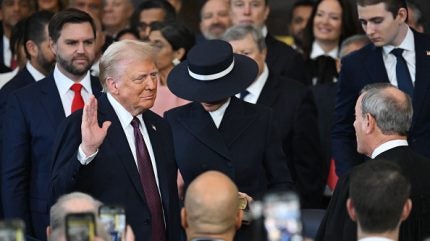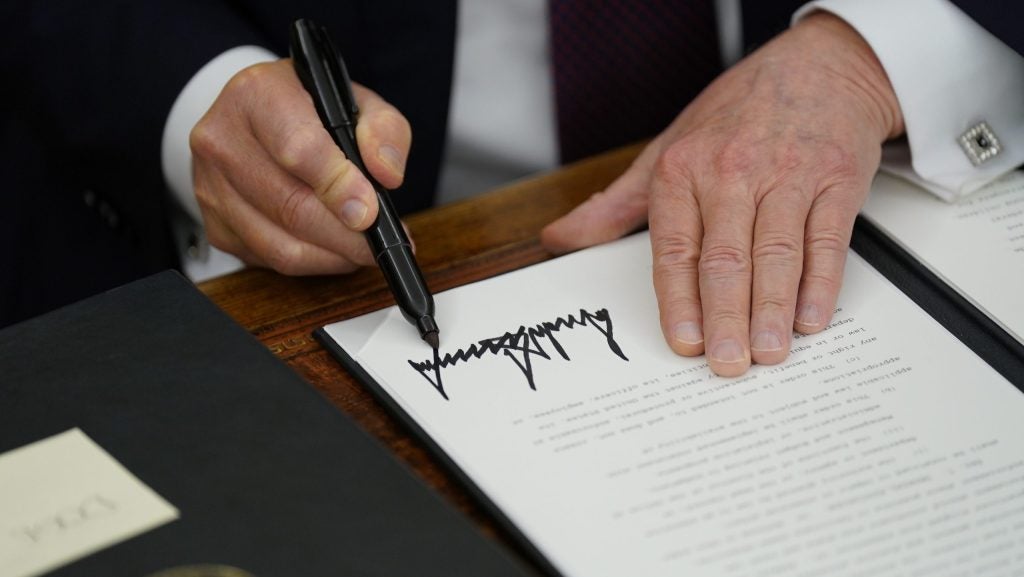
As promised, President Donald Trump hit the ground running with a swathe of executive orders issued on day one.
Executive orders are directives issued by the US president without having to consult Congress. They can be challenged in court or overturned by the next president.

Discover B2B Marketing That Performs
Combine business intelligence and editorial excellence to reach engaged professionals across 36 leading media platforms.
Trump had promised a flurry of such orders on day one and, true to his word, in his first day back in the White House yesterday (20 January) more than 100 such directives were signed.
Many overturned orders issued by the outgoing Biden Administration and, generally speaking, the new President stuck to the pre-Inauguration Day script with immigration and government reform to the fore.
A number of the orders could have consequences for the US food and beverage industry.
The US and the World Health Organization (WHO)
President Trump signed an executive order to begin the process of withdrawing the US from the WHO, remarking “oooh, that’s a big one,” as he signed.

US Tariffs are shifting - will you react or anticipate?
Don’t let policy changes catch you off guard. Stay proactive with real-time data and expert analysis.
By GlobalDataThe WHO is an agency of the United Nations responsible for global public health which promotes the control of epidemic and endemic diseases. America’s withdrawal requires a 12-month notice period.
Trump has long been critical of how the Switzerland-based institution handled Covid-19 and in the past has accused it of “ripping the US off”. He started the process of US withdrawal during his last term in office only for Biden to overturn the move after he took power in 2020.
Responding to yesterday’s news of the US’s intention to withdraw from the organisation, the WHO said it “regrets” the announcement and hopes the country will reconsider.
It added: “WHO plays a crucial role in protecting the health and security of the world’s people, including Americans, by addressing the root causes of disease, building stronger health systems and detecting, preventing and responding to health emergencies, including disease outbreaks, often in dangerous places where others cannot go.
“American institutions have contributed to and benefited from membership in WHO.
“With the participation of the United States and other member states, WHO has over the past seven years implemented the largest set of reforms in its history, to transform our accountability, cost-effectiveness, and impact in countries. This work continues.”
The US is the WHO’s biggest donor, contributing around 18% of its overall funding.
Lawrence Gostin, director of the WHO Collaborating Centre on Global Health Law at Georgetown University in the US, said: “A US withdrawal from WHO would make the world far less healthy and safe.
“It would make it more likely that we could see novel diseases spinning out of control, crossing borders, and potentially sparking a pandemic.”
Paris Climate Agreement
As expected, Trump ordered a US exit from the Paris Agreement, joining a small group of nations that are non-signatories including Yemen and Iran.
The Paris Agreement is a legally binding international treaty on climate change. It was adopted by 196 parties at the UN Climate Change Conference (COP21) in Paris in 2015 and entered into force in November 2016.
Its goal is to hold “the increase in the global average temperature to well below 2°C above pre-industrial levels” and pursue efforts “to limit the temperature increase to 1.5°C above pre-industrial levels”.
Trump is a climate change-sceptic and has re-stated his intention to invest in fossil fuel extraction using the phrase “drill baby, drill”.
Dr. Sylvain Charlebois, a professor and researcher of food distribution and policy at Dalhousie University in Canada, believes the US move could have a negative impact on Canada’s food manufacturers.
“Trump’s withdrawal from the Paris Agreement puts Canada in a tough spot. While we stick to climate commitments and a rising carbon tax, US industries face fewer regulations, creating competitiveness challenges,” he said in a social media post.
As part of an executive order on energy, Trump also halted the Green New Deal, a Biden Administration initiative aimed at boosting green jobs.
Immigration
Tackling illegal immigration has been Trump’s major focus, in and out of office, but above and beyond signing a directive to declare a national emergency at the US border with Mexico, he has also shut down a legal immigration pipeline.
A Biden Administration sponsorship initiative allowed migrants from Cuba, Haiti, Nicaragua and Venezuela to fly to the US.
Trump also suspended the US refugee resettlement programme for four months and re-implemented his ‘Remain in Mexico policy’ – returning non-Mexican asylum seekers across the border to await hearings.
Big meatpackers, and the US agri-food industry more generally, have widely used legal migrants in its factories and fields. A tighter labour supply could have implications on employee pay with increased costs potentially passed down the line to consumers.

Government reform and federal ‘lockdown’
Trump issued a directive – not an executive order – to all federal departments to address the cost-of-living crisis, tasking them with lowering the cost of, amongst other things, key household items, groceries and fuel. How this is to be achieved was not stated.
He has also created the Department of Government Efficiency (DOGE), which it is widely believed will be run by Tesla and SpaceX owner Elon Musk. The move is accompanied by a federal hiring freeze.
Trump additionally issued an order that said federal agencies cannot issue new regulations until the Trump Administration has full control.
In the final days of the Biden presidency, the US Food and Drug Administration (FDA) unveiled a number of initiatives which might be seen as trying to put the US food industry’s house in order before the new president took office.
These included plans to “enhance” oversight of infant-formula production as part of its strategy to ensure a “robust and nimble” US infant-formula supply chain, a proposal to ban the use of the so-called Red 3 food colouring additive in food, supplements and ingestible drugs and to mandate front-of-pack nutrition labels for most packaged foods.
Whether these initiatives will be overturned by the new regime remains to be seen.
Trump and tariffs
This was arguably the one executive order the global food and beverage industry feared the most and it did not happen, although it has widely been suggested this is just a stay of execution rather than a change of heart.
Pre-inauguration, Trump had threatened to increase tariffs – his favourite word, he said – on goods coming into the US from day one of taking office.
The incoming president pledged import duties of 25% on Canada and Mexico, as well as 10% on global imports and 60% on Chinese goods.
But yesterday, instead of signing the executive order to this effect, he said the tariffs on Canada and Mexico could come in on 1 February and ordered federal officials to review US trade relationships for unfair practices.
There have been many warnings that entering a trade war could hit US consumers in the pocket.
Writing today (21 January), Julian Jessop, economics fellow at the London-based think tank the Institute of Economic Affairs, said: “President Trump held back from introducing new tariffs on day one but still announced an overhaul of the US trade system which will lay the groundwork for more taxes on imports in future.
“Tariffs would be good for some US companies who might benefit from reduced competition but bad for others who would face higher costs. And they would be bad for US consumers, who would pay higher prices and have less choice.”
However, Dr. Charlebois is sceptical about whether the higher tariffs will be introduced.
“For food and agriculture, I will believe it when it happens,” he said in a social media post.





